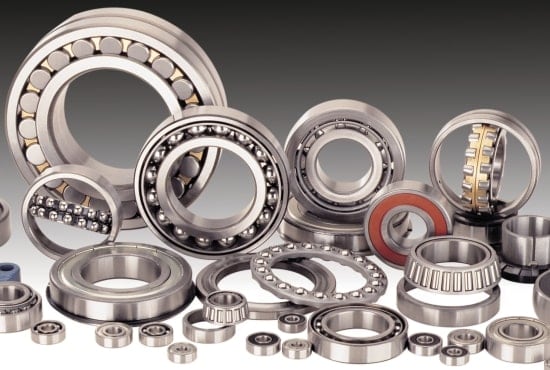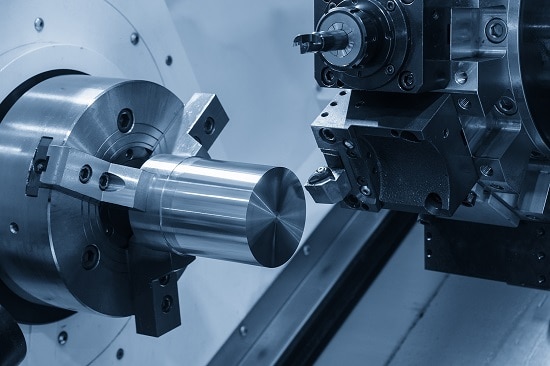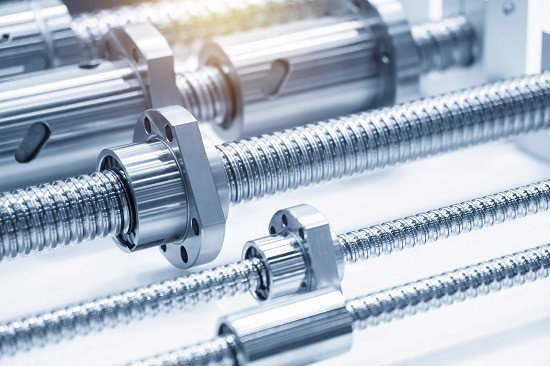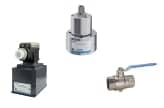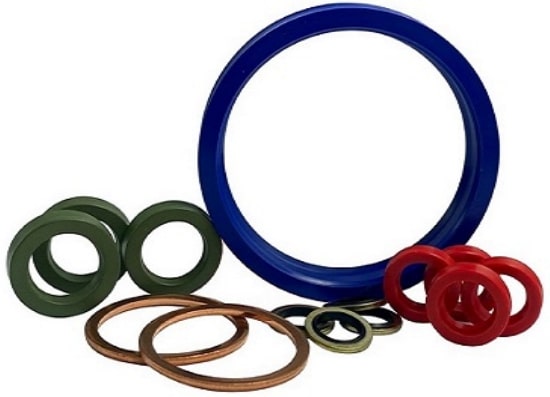Gearboxes
From now on, you will find our range of worm gears, racks and all necessary components for the realisation of complete rack gears in our onlineshop!
Ab jetzt finden Sie unser Sortiment an Schneckengetrieben und Zahnstangengetrieben der ATLANTA Antriebssysteme GmbH auch in unserem Onlineshop!
Startseite » Drive technology » Gearboxes
The task of gearboxes
In mechanical engineering, there are many technical systems that are often powered by motors. Ultimately, the delivered energy is then converted by other components, such as the chuck of a drilling machine. The mechanical power of the motors is often not directly utilized because the power needs to be provided in different ways depending on the situation. The power is designed either for maximum force or high speed. Gearboxes handle this control between force and speed (specifically torque and rotational speed). For this reason, gearboxes are important components in mechanical engineering. In summary, gearboxes not only transmit power but also influence the direction of rotation and control the rotational speed or torque.
The different types of gearboxes
Depending on the application, there are gearboxes available in many different designs. These include, for example, worm gearboxes, bevel gearboxes, planetary gearboxes, gear transmission , belt-driven gearboxes, or rolling-element gearboxes, with the fundamental physical processes for converting rotational speed and torque or speed and force being identical.
The following section provides a closer look at individual types of gearboxes that you can also find with us:
Worm gearboxes
Technical basics and the functioning of worm gearboxes
Worm gearboxes are highly precise and extremely powerful. They are also capable of reliably compensating for axial offsets. Worm gearboxes allow for a particularly high gear ratio in a compact space, making them excellent for applications with demanding space constraints. Due to these characteristics, worm gearboxes are widely used in demanding applications such as profile machining machines or conveyor systems.
This type of gearbox essentially consists of a linear, screw-like worm and a gear, known as the worm wheel, which is arranged at a 90-degree angle. Typically, the worm is responsible for the driving motion, while the worm wheel provides the output motion. For this reason, the worm is positioned on a worm shaft that is connected to a motor for driving. The “number of teeth” on the worm is also referred to as the gear ratio, and single-thread worms are commonly manufactured. In the case of a single-thread worm gearbox, as the worm completes one revolution, the thread advances by one position, causing the worm wheel to move forward by one tooth. In contrast, in a double-thread worm gearbox, two threads would advance one tooth each, resulting in the movement of two teeth of the worm wheel.
Due to the generally low gear ratio of the worm and the relatively large number of teeth on the worm wheel, worm gearboxes can achieve high gear ratios. Therefore, worm gearboxes allow for space-saving realization of very high gear ratios.
Since multiple thread sections of the worm wheel are generally engaged simultaneously in a worm gearbox, the load capacity of such gearboxes is very high, allowing for the transmission of substantial power. As a result, powerful rotational movements can be transmitted with relatively compact gearboxes. Furthermore, the contact between the worm wheel and the worm shaft, as well as the movement of the contact surfaces relative to each other, not only enable a positive force transmission but also ensure a sliding motion between the two components. This makes worm gearboxes particularly low-noise.
Finally, it should be noted that worm gearboxes (especially single-thread worm gearboxes) are often self-locking. This means that torque transmission can only occur in one direction, allowing the worm gearbox to be set in motion only through the gearbox input (drive) and not through the gearbox output (output). The self-locking property plays an important role in specific applications, such as lifting devices, where it can prevent the device from descending when the motor is turned off.
What types of worm gearboxes exist?
Depending on the shape of the worm of a worm gear, a distinction is made between cylindrical and globoidal worms.
Cylindrical screws
If the outer shape of the worm is cylindrical, it is called a cylindrical worm. If the cross-section of the worm wheel has this cylindrical profile on the circumference, it is called a globoid worm wheel. Due to the relatively simple production of a cylindrical worm, this variant is preferably used (cylindrical worm gear).
Globoid worms
If the outer shape of the worm forms an arc, it is referred to as a globoid worm. In this case, the worm partially envelops the globoid worm wheel. This characteristic allows multiple thread sections to be involved in power transmission, enabling higher power transfer compared to cylindrical worms.
Buy worm gears from ATLANTA Antriebssysteme at PACH Systems
The HT-High Torque Servo, HP-High Performance and E-Economy worm gearboxes from ATLANTA Antriebssysteme have been specially developed for use with new generation three-phase and DC servo motors.
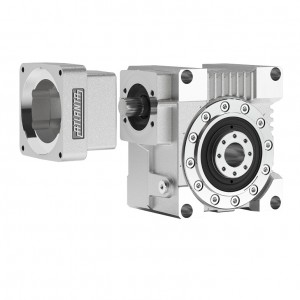
HT-High Torque Servo worm gear units
- Backlash< 1 arcmin, adjustable
- 4 sizes: centre distance 50, 63, 80 and 100mm
- 8 ratios: 4.75; 6.75; 9.25; 14.5; 19.5; 29; 39; 50 and 52:1
- Output torque: from 90 to 1700 Nm
- Output hollow shaft: Interface according EN ISO 9409-1-A, clamp connection, generously dimensioned and supported for high additional forces
- Highest rigidity
- Highest precision
- ATEX design available
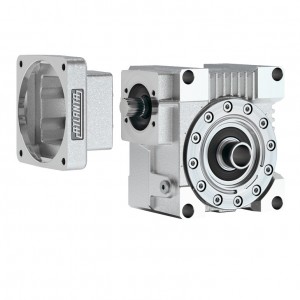
HP-High Torque Servo worm gear units
- Backlash< 2 arcmin, adjustable
- 5 sizes: centre distance 50, 63, 80, 100 and 125mm
- 9 ratios: 4.75; 6.75; 9.25; 14.5; 19.5; 29; 39; 50 and 52:1
- Output torque: from 60 to 2200 Nm
- Output hollow shaft: key connection, clamp connection, generously dimensioned and supported for high additional forces
- Very high rigidity
- Very high precision
- ATEX design available
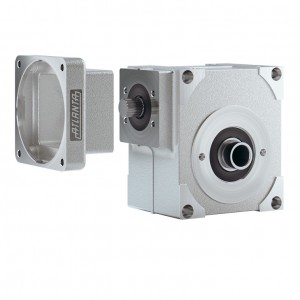
E-Economy Servo worm gear units
- Backlash < 5 arcmin
- 5 sizes: centre distance 32, 50, 63, 80 and 100mm
- 9 ratios: 4.75; 6.75; 9.25; 14.5; 19.5; 29; 39; 50 and 52:1
- Output torque: from 11 to 1100 Nm
- Output hollow shaft: key connection, clamp connection, generously dimensioned and supported for high additional forces
- High rigidity
- High precision
- ATEX design available
Bevel gearboxes
Function and construction of a bevel gearboxes
The special feature of bevel gears (sometimes also referred to as angle gears) is that the axes of the bevel gears are usually perpendicular to each other and intersect at a single point. Thus, the bevel gears are used to change the direction of rotation. By using bevel gears (bevel gearboxes), the rotational axes of the gear shafts can be rotated at any angle relative to each other. Often, the angle is 90 degrees. Bevel gearboxes consist of a bevel gear (also known as a crown gear) and a bevel pinion. The tooth engagement can be straight, helical, or curved.
The different tooth profiles of bevel gears
Straight toothed
A straight-tooth profile is referred to when the teeth run linearly, that is, in a radial direction towards the axis of rotation of the gear.
Curved tooth profile / helical tooth profile
In this case, the flank lines no longer run radially outward but have a specific helix. This results in a curved tooth profile, which can have a spiral, involute, cycloidal, or circular shape. This type of tooth profile is often preferred over straight-tooth profiles in bevel gears because it offers more favorable engagement conditions, higher torque transmission capacity, lower noise generation, and greater installation tolerances.
Crown wheel
A special form is represented by the crown gear. In this case, a conventional spur gear is used as the pinion. The tooth profile of the crown gear can also be straight, helical, or curved.
Planetary gears
The structure of a planetary gears
A planetary gearbox essentially consists of four elements: the sun gear, planet gears, a ring gear, and a planet carrier. The sun gear, with external teeth, is centrally located in the housing and is driven by a motor. The planet gears, also with external teeth, surround the sun gear. Their orbit is limited by the ring gear with internal teeth. Finally, the planet carrier serves as a connecting element for the planet gears and forms the output shaft of the gearbox.
The task of a planetary gears
By using a planetary gears, the performance of the complete drive train can be increased, because with the right gear, the motor can be selected smaller, which saves costs and increases the efficiency of the entire drive train in operation.
In general, planetary gearheads are high-precision gearheads, which is why they are mainly used in applications where high positioning accuracy is required. Thus, typical areas of application are high-precision positioning tasks (servo applications), e.g. in machining axes.
Rack drives
The operation of rack and pinion drives
Buy rack and pinion gear units from ATLANTA Antriebssysteme at PACH Systems
With more than 350 rack types,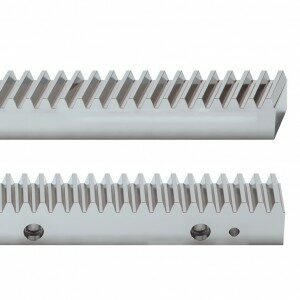 the rack programme of ATLANTA Antriebssysteme GmbH is probably one of the most extensive on the current market. The four rack classes Ultra High Precision Rack, High Precision Rack, Precision Rack and Basic Rack are available in qualities from 5 to 10, in helical or straight toothed design, milled or hardened as well as hardened and ground and that in sizes from module 1.5 to 12.
the rack programme of ATLANTA Antriebssysteme GmbH is probably one of the most extensive on the current market. The four rack classes Ultra High Precision Rack, High Precision Rack, Precision Rack and Basic Rack are available in qualities from 5 to 10, in helical or straight toothed design, milled or hardened as well as hardened and ground and that in sizes from module 1.5 to 12.
In addition to the racks, you can also obtain various gear wheels, pinion shafts and lubrication systems from us for the realisation of complete rack and pinion gears.
You can find our range of racks, pinions and pinion shafts and lubrication systems directly in our online shop. If the products available in the online shop do not meet your requirements, please contact us via our contact form or send us an email to info[at]pach-systems.de.

